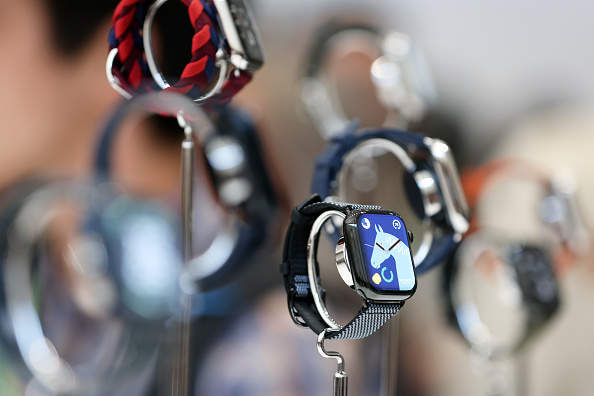Apple Watch Series 9 Review: Why the Watch Isn’t as Useful as It Could Be
It has a new double-tap feature and brighter screen, but latest model has same battery life the watches have had since 2015: 18 hours
If you asked me, “Should I upgrade my Apple Watch to the Series 9 this year?” I’d probably say no.
It’s a fine watch. It’s just not much better than the Series 8, which you can get cheaper, even refurbished right from Apple.
I have been testing the $399-and-up Series 9 for nearly a week. Available on Sept. 22, it includes a few upgrades, including a one-handed, double-tap gesture and a brighter screen. Apple says one version of it—the aluminum case with Sport Loop band—is carbon neutral.
Many things, though, remain unchanged from last year’s, including the health sensors and design. I’m most grumpy about the battery life. Back in 2015, Apple promised 18 hours. Today, Apple promises…18 hours. Eight years and a dozen models later, we still need to charge these watches daily.
The Apple Watch is the bestselling smartwatch in the world, but battery life is where competitors such as Garmin still have an edge. It’s what holds the Apple Watch back from true all-day/all-night/all-weekend usefulness.
Double tap and new features
The improvements to the Series 9 are internal, enabling new features that are nice-to-haves. There are no game-changers.
Double tap: The new watch senses when you pinch your thumb and index finger twice, in quick succession. The gesture triggers an action that varies depending on what you’re doing. If you’re playing a song, you can double-tap to pause or skip. For incoming texts, it starts a reply with voice dictation. For calls, it picks up the phone. For timers, it dismisses the alert.
Double tap will come in an update rolling out next month. It’s useful for one-handed operation, while you’re holding on to a subway pole or cup of coffee. It also works while you’re wearing gloves.
A similar accessibility feature called AssistiveTouch is available on Series 4 models and newer. You can even double-pinch to dismiss notifications. In my tests, AssistiveTouch wasn’t always as responsive as double-tapping on the Series 9, but if you already have an Apple Watch, it’s worth enabling.
Offline Siri: Apple’s voice assistant can now process some queries faster and more accurately, because it doesn’t need to send the request to the server over Wi-Fi or cellular. You can set timers—even multiple timers in the WatchOS 10—almost instantaneously.
Brighter screen: The display goes up to 2,000 nits, up from 1,000 nits last year. If you don’t speak nits, that translates to a screen that’s easier to see outdoors on a sunny day. Its dimmest setting is also lower, way down to one nit. The Apple Watch adjusts screen brightness automatically based on ambient light, so the brighter screen isn’t noticeable in most settings.
Precision iPhone finding: I use my Apple Watch’s Find My iPhone ping basically every day, so I thought I’d like precision finding. When you’re within about 30 feet of the iPhone, you can see its distance and direction—similar to an AirTag. It’s nice for those who might be unable to hear the audible ping triggered by older models, but that never failed me. And this trick only works with an iPhone 15 model.
Stalled battery life
In its quest to make the smartwatch a jack-of-all-trades wearable with a high-resolution, multitouch screen, Apple has sacrificed battery life. The new S9 processor is 25% more power efficient than last year’s model. But over the years, the company has added more sensors, brighter screens and other energy-sucking elements.
During the watch’s recent unveiling, Deidre Caldbeck, the director of Apple Watch product marketing, highlighted the company priority: “This powerful custom silicon is what allows us to maintain all-day 18-hour battery life while adding new features and systemwide improvements.”
Garmin wearables, meanwhile, have lower-resolution displays that can last days. Some models have solar panels embedded in their watch faces, and can last weeks. It’s something I’m painfully reminded of every time I forget my Apple Watch charger on a weekend trip. Cue the gloating by my Garmin-wearing husband, who never brings his charger.
Apple often touts the watch’s health-tracking capabilities in marketing materials. For this to work, though, it has to be on your wrist—even at night, while you sleep. That’s tough when it needs to be charged once a day.
Charging wouldn’t be as problematic if the Apple Watch didn’t need its own proprietary puck to power up. (Garmin’s new Vivomove Trend is one of the first to work with standard Qi wireless charging.)
I’m not saying Apple Watches are useless without default multi day battery life. I wear mine so often that I have a squircle-shaped tan on my wrist. But a battery-life quantum leap is needed.
That could be coming next year. The Apple Watch was announced 10 years ago next fall, and that anniversary could mean a big redesign. According to a Bloomberg report, a new band system could make room in the watch’s case for more sensors—or, I hope, a bigger battery—and a switch to a more energy-efficient microLED display could lead to power gains.
How to get longer battery life
If you want the longest battery life right now, there’s the $799 Apple Watch Ultra. It lasts a day and a half by default. But even the new, modestly upgraded model is a bulky chunkster, especially on smaller wrists. Anyone else looking for a big Apple Watch change should wait until 2024.
Meanwhile, you can temporarily double the battery life by taking away power-draining features.
• Enable low-power mode: You can quickly enable low-power mode for set periods. Press the side button to open the Control Center, then tap on the battery percentage and scroll down.
Just beware: It does disable some of the lifesaving heart-rate notifications and the power-hungry always-on display. When double tap is available, low-power mode will also disable that gesture.
• Reduce workout sensor readings: Go to Settings > Workout, then tap Fewer GPS and Heart Rate Readings to enable. When in low-power mode, the watch won’t capture GPS or heart-rate data as frequently during outdoor workouts, further extending battery life.
You can also disable some functions. I managed to squeeze 48 hours out of the Series 9 by turning off the most battery-intensive ones, but it’s a trade-off:
• Double tap: When the feature rolls out to Series 9 models next month, you can turn it off. Go to Settings > Gestures > Double Tap to disable.
• Always-on display: Go to Settings > Display & Brightness. Tap Always On to disable.
• Background app refresh: Go to Settings > General. Scroll down to Background App Refresh to disable entirely or turn off for certain apps.
• Reduce display brightness: In Settings > Display & Brightness, you can adjust the default setting.
 Copyright 2020, Dow Jones & Company, Inc. All Rights Reserved Worldwide. LEARN MORE
Copyright 2020, Dow Jones & Company, Inc. All Rights Reserved Worldwide. LEARN MORE
This stylish family home combines a classic palette and finishes with a flexible floorplan
Just 55 minutes from Sydney, make this your creative getaway located in the majestic Hawkesbury region.
As Paris makes its final preparations for the Olympic games, its residents are busy with their own—packing their suitcases, confirming their reservations, and getting out of town.
Worried about the hordes of crowds and overall chaos the Olympics could bring, Parisians are fleeing the city in droves and inundating resort cities around the country. Hotels and holiday rentals in some of France’s most popular vacation destinations—from the French Riviera in the south to the beaches of Normandy in the north—say they are expecting massive crowds this year in advance of the Olympics. The games will run from July 26-Aug. 1.
“It’s already a major holiday season for us, and beyond that, we have the Olympics,” says Stéphane Personeni, general manager of the Lily of the Valley hotel in Saint Tropez. “People began booking early this year.”
Personeni’s hotel typically has no issues filling its rooms each summer—by May of each year, the luxury hotel typically finds itself completely booked out for the months of July and August. But this year, the 53-room hotel began filling up for summer reservations in February.
“We told our regular guests that everything—hotels, apartments, villas—are going to be hard to find this summer,” Personeni says. His neighbours around Saint Tropez say they’re similarly booked up.
As of March, the online marketplace Gens de Confiance (“Trusted People”), saw a 50% increase in reservations from Parisians seeking vacation rentals outside the capital during the Olympics.
Already, August is a popular vacation time for the French. With a minimum of five weeks of vacation mandated by law, many decide to take the entire month off, renting out villas in beachside destinations for longer periods.
But beyond the typical August travel, the Olympics are having a real impact, says Bertille Marchal, a spokesperson for Gens de Confiance.
“We’ve seen nearly three times more reservations for the dates of the Olympics than the following two weeks,” Marchal says. “The increase is definitely linked to the Olympic Games.”

Getty Images
According to the site, the most sought-out vacation destinations are Morbihan and Loire-Atlantique, a seaside region in the northwest; le Var, a coastal area within the southeast of France along the Côte d’Azur; and the island of Corsica in the Mediterranean.
Meanwhile, the Olympics haven’t necessarily been a boon to foreign tourism in the country. Many tourists who might have otherwise come to France are avoiding it this year in favour of other European capitals. In Paris, demand for stays at high-end hotels has collapsed, with bookings down 50% in July compared to last year, according to UMIH Prestige, which represents hotels charging at least €800 ($865) a night for rooms.
Earlier this year, high-end restaurants and concierges said the Olympics might even be an opportunity to score a hard-get-seat at the city’s fine dining.
In the Occitanie region in southwest France, the overall number of reservations this summer hasn’t changed much from last year, says Vincent Gare, president of the regional tourism committee there.
“But looking further at the numbers, we do see an increase in the clientele coming from the Paris region,” Gare told Le Figaro, noting that the increase in reservations has fallen directly on the dates of the Olympic games.
Michel Barré, a retiree living in Paris’s Le Marais neighbourhood, is one of those opting for the beach rather than the opening ceremony. In January, he booked a stay in Normandy for two weeks.
“Even though it’s a major European capital, Paris is still a small city—it’s a massive effort to host all of these events,” Barré says. “The Olympics are going to be a mess.”
More than anything, he just wants some calm after an event-filled summer in Paris, which just before the Olympics experienced the drama of a snap election called by Macron.
“It’s been a hectic summer here,” he says.

AFP via Getty Images
Parisians—Barré included—feel that the city, by over-catering to its tourists, is driving out many residents.
Parts of the Seine—usually one of the most popular summertime hangout spots —have been closed off for weeks as the city installs bleachers and Olympics signage. In certain neighbourhoods, residents will need to scan a QR code with police to access their own apartments. And from the Olympics to Sept. 8, Paris is nearly doubling the price of transit tickets from €2.15 to €4 per ride.
The city’s clear willingness to capitalise on its tourists has motivated some residents to do the same. In March, the number of active Airbnb listings in Paris reached an all-time high as hosts rushed to list their apartments. Listings grew 40% from the same time last year, according to the company.
With their regular clients taking off, Parisian restaurants and merchants are complaining that business is down.
“Are there any Parisians left in Paris?” Alaine Fontaine, president of the restaurant industry association, told the radio station Franceinfo on Sunday. “For the last three weeks, there haven’t been any here.”
Still, for all the talk of those leaving, there are plenty who have decided to stick around.
Jay Swanson, an American expat and YouTuber, can’t imagine leaving during the Olympics—he secured his tickets to see ping pong and volleyball last year. He’s also less concerned about the crowds and road closures than others, having just put together a series of videos explaining how to navigate Paris during the games.
“It’s been 100 years since the Games came to Paris; when else will we get a chance to host the world like this?” Swanson says. “So many Parisians are leaving and tourism is down, so not only will it be quiet but the only people left will be here for a party.”
This stylish family home combines a classic palette and finishes with a flexible floorplan
Just 55 minutes from Sydney, make this your creative getaway located in the majestic Hawkesbury region.






















